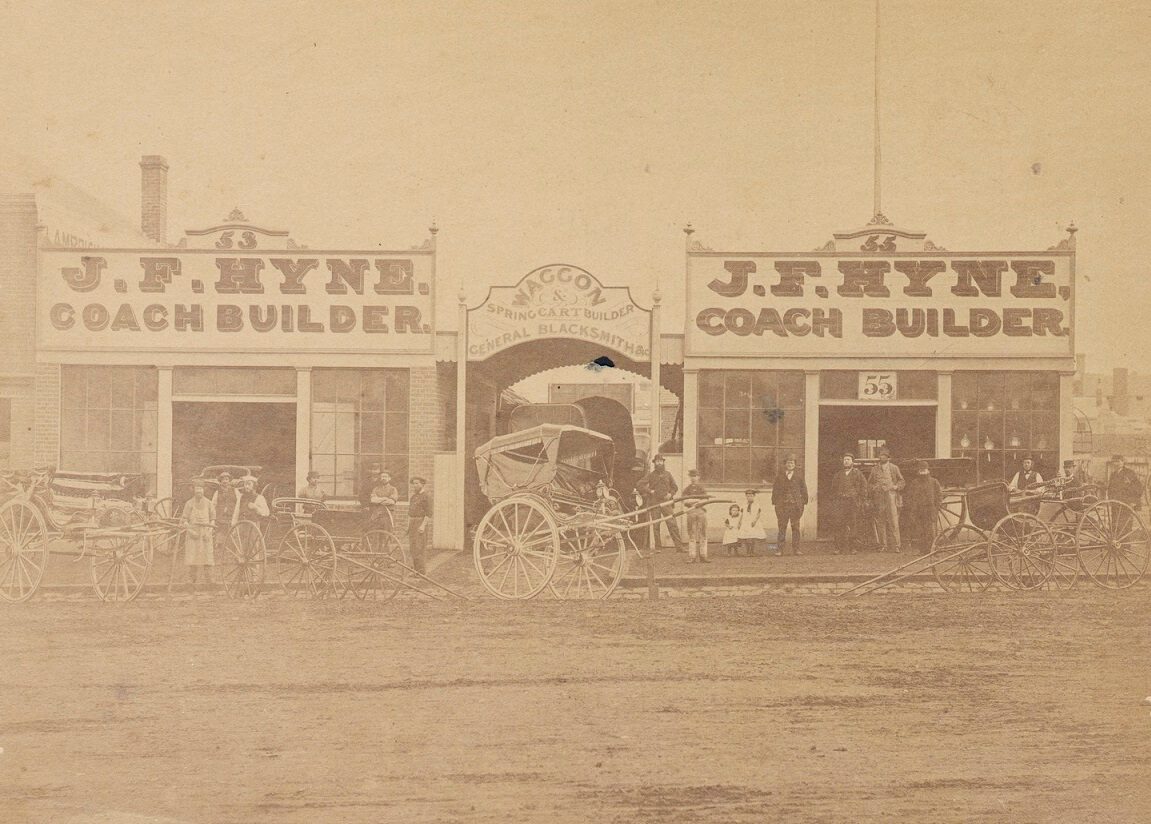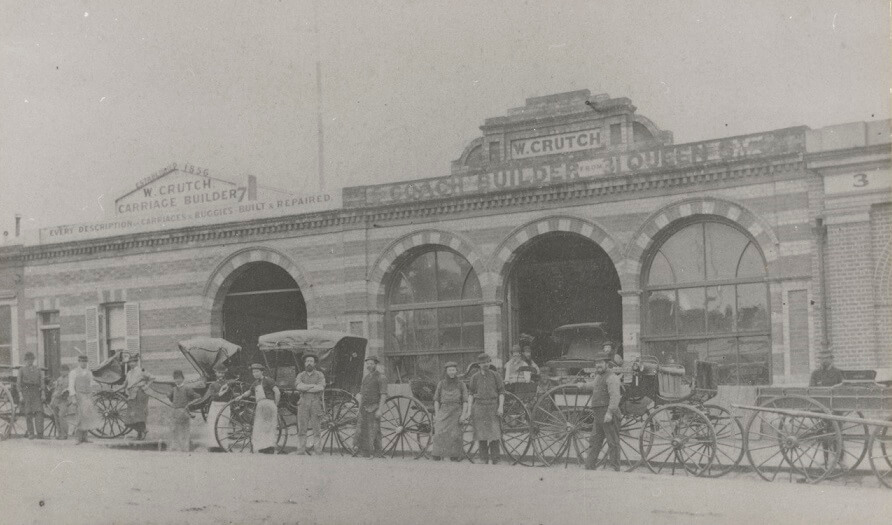Imported English coaches proved fragile and unsuited to rough roads, encouraging the development of a local coach, cart and wagon-making industry. In 1849 three coachbuilders set up shop in Melbourne: ten years later, there were 49.
J.F.Hyne, coachbuilder, Melbourne, by unknown photographer, c.1900
Reproduced courtesy State Library Victoria
There were five distinct trades involved in coach building — the body builder, the wheelwright, the blacksmith, the painter and the trimmer. For more elaborate vehicles, specialised workers such as tinsmiths, silversmiths, goldsmiths and coppersmiths were employed to add finishing touches. Coachbuilding was a labour-intensive industry. Historian, Douglas P. Keep, describes the work involved:
Firstly there was the Body Builder, a kind of super carpenter who worked with selected timbers, fashioned the woodwork of the body, made the seats and dressed the shafts… he made the vehicle "in the wood" according to the overall design.
Next was the wheelwright who fashioned his hub or nave, mortised it to take the spokes, drove the spokes into position and fitted the rim or felloes so that the wheel was a perfect circle, correct with its slight "dish" all ready to be tyred and boxed to take the axle.
Then there was the smith who not only tyred the wheels by making a circle of iron for each wheel just a shade smaller than the circumference and after heating it all over in a furnace, would drop the expanded hoop over the wheel and then plunge it all into water causing the iron tyre to immediately shrink thus holding all together. The smith also fashioned all the ironwork for the vehicle, the forecarriage, the springs and shackles, the steps and the lamp irons and he also did that most important job of welding and setting the axle. The axle would have been procured from the merchant in two halves and these had to be welded together at the right place to give the correct distance between the wheels and had to be set so that the wheels would run truly on the road.
The vehicle would now have been ready for the trimmer. Working in leather, imitation leathers, canvas and ducks, his job was to make the cushions, squabs and falls for the seats. He would have inserted springs and flock filling as needed and sewn the lot together in a similar manner to an upholsterer, never leaving a trace of a join in the finished job. He also made the hood, stretching the material over the bent blackwood bows and lastly make the side curtains. "The Isinglass curtains that roll right down in case there's a change in the weather," and if the vehicle were indeed a Surrey, there must have been a fringe on the top.
Now the vehicle stands completed. Wheels on, trimming in place all ready for the road except that the painter must do his important job. In those days ready mixed paints were not available and part of the painter's job was to prepare the materials for his undercoats and fillers, mix the colours he required in a paint mill and by judicious mixture of linseed oil and turpentine obtain the required result. This was part of his skill.
First he applied a primer or first undercoat and when it was dry he would rub down the job with sandpaper and fill any tiny crevices or pin holes then paint on a second undercoat which must also be rubbed down, then a third or more according to the perfection required of the finished job. Then the colours must be chosen and the paint prepared and with careful brushwork the first and then the second coat of colour would be added and rubbed down with pumice in preparation for the final coats of varnish. The wheels which would been taken off to be painted separately, would be lined with thin lines drawn down the spokes in contrasting colours. These would be painted freehand by the painter skilfully running his fine "Lark" brush down the length of each spoke using his fingers as a guide. The shafts of the vehicle would also be decorated with finely drawn lines and a decorative design drawn on the back of the seat.
If the painter were extremely capable and experienced he could even paint freehand, the correct crest or coat of arms on the door of a family carriage or the name and advertisement on a tradesman's delivery waggon. If he were not quite so skilful he could obtain and use transfers. These were manufactured in Europe but were sold by Melbourne wholesale suppliers. Transfers could be obtained for all types of lettering, scrollwork, loops and bows and also in a great number of more ambitious designs appropriate to special needs. For instance the side panels of a baker's cart gave great opportunity for artistic decoration and a transfer wheatsheaf could be applied to the centre of each panel and the name of the owner and other information in transfer lettering where desired. The painter could then extend the wheatsheaf in freehand lengthening the stalks and so on, thus making, if little else, his individual contribution.
Crutch, coachbuilder, Latrobe Street, Melbourne, by unknown photographer, c.1881
Reproduced courtesy State Library Victoria
A well-equipped carriage works employed at least 20 people. One firm, Stevenson & Elliott, on the corner of Lonsdale and King streets, had more than 70 men on its payroll.
The arrival of the motor car spelled the end of the coachbuilding industry, although some skilled workers transferred to automotive construction and maintenance.


